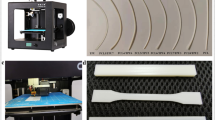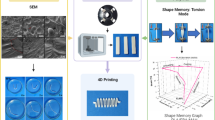Abstract
In this study, PLA-TPU blends with different component ratios were prepared and printed by melt blending and fused deposition modeling (FDM), respectively. The shape memory effect (SME) was investigated considering the effect of loading mode, programming deformation, and temperature for three combinations of PLA50, 70, and 90 wt%. The results of the thermal analysis showed that each compound had two glass transition temperatures in the range of −20 and 67 °C, which return to TPU and PLA, respectively. SEM results confirmed that TPU droplets are observed in the PLA matrix and the printed samples had stretched the TPU phase. In both loading modes, with the increase in PLA concentration, the fixity ratio increased and the highest shape recovery value was obtained in the PLA70 samples, although the values were very close to PLA50. The crystalline segments of PLA, as a net point, play an essential role in restoring the original shape, and by increasing the amount of PLA, stricter limitations are created. In the compression mode, although the programming stress was the highest in the cold-programmed sample, the highest stress was released in the warm-programmed samples. The maximum recovery stress value for PLA70 was 12.85 MPa, which can be effective in reducing the limitations of applications for shape memory polymers. The shape recovery ratio was in the 90.9–96.4% range under compression loading. Also, the cold-programmed samples showed the highest and lowest fixity and recovery ratios. The results of this research show that by changing the composition and programming temperature, the desired properties for different applications can be achieved so that the highest fixity, recovery, and stress recovery were obtained in hot, cold, and warm-programmed samples by manipulating the input energy and temperature.
Graphical abstract












Similar content being viewed by others
Data and code availability
Not Applicable.
References
Ahmadi M, Tabary SAAB, Rahmatabadi D et al (2022) Review of selective laser melting of magnesium alloys: advantages, microstructure and mechanical characterizations, defects, challenges, and applications. J Mater Res Technol 19:1537–1562. https://doi.org/10.1016/J.JMRT.2022.05.102
Lan W, Huang X, Huang D et al (2022) (2022) Progress in 3D printing for bone tissue engineering: a review. J Mater Sci 5727:12685–12709. https://doi.org/10.1007/S10853-022-07361-Y
Askari M, Afzali Naniz M, Kouhi M et al (2021) Recent progress in extrusion 3D bioprinting of hydrogel biomaterials for tissue regeneration: a comprehensive review with focus on advanced fabrication techniques. Biomater Sci 9:535–573. https://doi.org/10.1039/d0bm00973c
Abedi HR, Hanzaki AZ, Azami M et al (2019) The high temperature flow behavior of additively manufactured Inconel 625 superalloy. Mater Res Express. https://doi.org/10.1088/2053-1591/ab44f6
Shirzad M, Zolfagharian A, Matbouei A, Bodaghi M (2021) Design, evaluation, and optimization of 3D printed truss scaffolds for bone tissue engineering. J Mech Behav Biomed Mater 120:104594. https://doi.org/10.1016/j.jmbbm.2021.104594
Dolatabadi R, Mohammadi A, Walker RB (2022) A novel three-dimensional printed device with conductive elements for electromembrane extraction combined with high-performance liquid chromatography and ultraviolet detector. J Sep Sci 45:3187–3196. https://doi.org/10.1002/JSSC.202200028
Valino AD, Dizon JRC, Espera AH et al (2019) Advances in 3D printing of thermoplastic polymer composites and nanocomposites. Prog Polym Sci 98:101162
Moradi M, Aminzadeh A, Rahmatabadi D (2021) Rasouli SA (2021) statistical and experimental analysis of process parameters of 3D nylon printed parts by fused deposition modeling: response surface modeling and optimization. J Mater Eng Perform 307:5441–5454. https://doi.org/10.1007/S11665-021-05848-4
Moradi M, Aminzadeh A, Rahmatabadi D, Hakimi A (2021) Experimental investigation on mechanical characterization of 3D printed PLA produced by fused deposition modeling (FDM). Mater Res Express 8:035304. https://doi.org/10.1088/2053-1591/abe8f3
Bodaghi M, Liao WH (2019) 4D printed tunable mechanical metamaterials with shape memory operations. Smart Mater Struct 28:045019. https://doi.org/10.1088/1361-665X/AB0B6B
Rahmatabadi D, Aberoumand M, Soltanmohammadi K et al (2022) A new strategy for achieving shape memory effects in 4D printed two-layer composite structures. Polym 14:5446. https://doi.org/10.3390/POLYM14245446
Rahmatabadi D, Soltanmohammadi K, Aberoumand M et al (2022) Development of pure poly vinyl chloride (PVC) with excellent 3D printability and macro- and micro-structural properties. Macromol Mater Eng. https://doi.org/10.1002/MAME.202200568
Cheng P, Peng Y, Li S et al (2023) 3D printed continuous fiber reinforced composite lightweight structures: a review and outlook. Compos Part B Eng 250:110450. https://doi.org/10.1016/J.COMPOSITESB.2022.110450
Bodaghi M, Damanpack AR, Liao WH (2018) Triple shape memory polymers by 4D printing. Smart Mater Struct 27:065010. https://doi.org/10.1088/1361-665X/aabc2a
Penumakala PK, Santo J, Thomas A (2020) A critical review on the fused deposition modeling of thermoplastic polymer composites. Compos Part B Eng 201:108336
Xiao X, Kong D, Qiu X et al (2015) Shape-memory polymers with adjustable high glass transition temperatures. Macromolecules 48:3582–3589. https://doi.org/10.1021/acs.macromol.5b00654
Rahmatabadi D, Aberoumand M, Soltanmohammadi K et al (2022) 4D printing-encapsulated polycaprolactone-thermoplastic polyurethane with high shape memory performances. Adv Eng Mater. https://doi.org/10.1002/ADEM.202201309
Soleyman E, Aberoumand M, Soltanmohammadi K et al (2022) 4D printing of PET-G via FDM including tailormade excess third shape. Manuf Lett 33:1–4. https://doi.org/10.1016/J.MFGLET.2022.05.002
Zhang Z, Demir KG, Gu GX (2019) Developments in 4D-printing: a review on current smart materials, technologies, and applications. Int J Smart Nano Mater 10:205–224. https://doi.org/10.1080/19475411.2019.1591541
Aberoumand M, Soltanmohammadi K, Rahmatabadi D, et al (2023) 4D printing of polyvinyl chloride (PVC): a detailed analysis of microstructure, programming, and shape memory performance. Macromol Mater Eng Accepted
Zhao Q, Qi HJ, Xie T (2015) Recent progress in shape memory polymer: new behavior, enabling materials, and mechanistic understanding. Prog Polym Sci 49–50:79–120
Soleyman E, Aberoumand M, Rahmatabadi D et al (2022) Assessment of controllable shape transformation, potential applications, and tensile shape memory properties of 3D printed PETG. J Mater Res Technol 18:4201–4215. https://doi.org/10.1016/J.JMRT.2022.04.076
Miao S, Nowicki M, Cui H et al (2019) 4D anisotropic skeletal muscle tissue constructs fabricated by staircase effect strategy. Biofabrication 11:035030. https://doi.org/10.1088/1758-5090/AB1D07
Peng B, Yang Y, Ju T, Cavicchi KA (2021) Fused filament fabrication 4d printing of a highly extensible, self-healing, shape memory elastomer based on thermoplastic polymer blends. ACS Appl Mater Interfaces 13:12777–12788. https://doi.org/10.1021/acsami.0c18618
Aberoumand M, Soltanmohammadi K, Soleyman E et al (2022) A comprehensive experimental investigation on 4D printing of PET-G under bending. J Mater Res Technol 18:2552–2569. https://doi.org/10.1016/J.JMRT.2022.03.121
Melly SK, Liu L, Liu Y, Leng J (2020) On 4D printing as a revolutionary fabrication technique for smart structures. Smart Mater Struct 29:083001. https://doi.org/10.1088/1361-665X/AB9989
Tao Y, Kong F, Li Z et al (2021) A review on voids of 3D printed parts by fused filament fabrication. J Mater Res Technol 15:4860–4879. https://doi.org/10.1016/J.JMRT.2021.10.108
Liu H, He H, Huang B (2020) Favorable thermoresponsive shape memory effects of 3D printed poly(lactic acid)/poly(ε-caprolactone) blends fabricated by fused deposition modeling. Macromol Mater Eng 305:2000295. https://doi.org/10.1002/mame.202000295
Lin C, Liu L, Liu Y, Leng J (2022) 4D printing of shape memory polybutylene succinate/polylactic acid (PBS/PLA) and its potential applications. Compos Struct 279:114729. https://doi.org/10.1016/J.COMPSTRUCT.2021.114729
Jašo V, Cvetinov M, Rakic SSS, Petrovic ZS (2014) Bio-plastics and elastomers from polylactic acid/thermoplastic polyurethane blends. J Appl Polym Sci 131:41104. https://doi.org/10.1002/APP.41104
Zhao X, Ye L, Coates P et al (2013) Structure and blood compatibility of highly oriented poly(lactic acid)/thermoplastic polyurethane blends produced by solid hot stretching. Polym Adv Technol 24:853–860. https://doi.org/10.1002/PAT.3156
Han JJ, Huang HX (2011) Preparation and characterization of biodegradable polylactide/thermoplastic polyurethane elastomer blends. J Appl Polym Sci 120:3217–3223. https://doi.org/10.1002/APP.33338
Kačergis L, Mitkus R, Sinapius M (2019) Influence of fused deposition modeling process parameters on the transformation of 4D printed morphing structures. Smart Mater Struct. https://doi.org/10.1088/1361-665X/ab3d18
Zhang W, Chen L, Zhang Y (2009) Surprising shape-memory effect of polylactide resulted from toughening by polyamide elastomer. Polymer (Guildf) 50:1311–1315. https://doi.org/10.1016/j.polymer.2009.01.032
Lai S-M, Lan Y-C (2013) Shape memory properties of melt-blended polylactic acid (PLA)/thermoplastic polyurethane (TPU) bio-based blends. J Polym Res 20:140. https://doi.org/10.1007/s10965-013-0140-6
Jing X, Mi H-Y, Peng X-F, Turng L-S (2015) The morphology, properties, and shape memory behavior of polylactic acid/thermoplastic polyurethane blends. Polym Eng Sci 55:70–80. https://doi.org/10.1002/pen.23873
Ping P, Wang W, Chen X, Jing X (2005) Poly(ε-caprolactone) polyurethane and its shape-memory property. Biomacromol 6:587–592. https://doi.org/10.1021/bm049477j
Li G, Wang A (2016) Cold, warm, and hot programming of shape memory polymers. J Polym Sci Part B Polym Phys 54:1319–1339. https://doi.org/10.1002/polb.24041
Mazurek-Budzyńska M, Razzaq MY, Behl M, Lendlein A (2019) Shape-memory polymers
Wang A, Li G (2015) Stress memory of a thermoset shape memory polymer. J Appl Polym Sci. https://doi.org/10.1002/APP.42112
Soleyman E, Rahmatabadi D, Soltanmohammadi K et al (2022) Shape memory performance of PETG 4D printed parts under compression in cold, warm, and hot programming. Smart Mater Struct 31:085002. https://doi.org/10.1088/1361-665X/AC77CB
Zhang W, Chen L, Zhang Y (2009) Investigation into stress recovery behavior of shape memory polyurethane fiber. Polymer (Guildf) 50:1311–1315. https://doi.org/10.1002/polb.23582
Li G, Xu W (2011) Thermomechanical behavior of thermoset shape memory polymer programmed by cold-compression: testing and constitutive modeling. J Mech Phys Solids 59:1231–1250. https://doi.org/10.1016/J.JMPS.2011.03.001
Fritzsche N, Pretsch T (2014) Programming of temperature-memory onsets in a semicrystalline polyurethane elastomer. Macromolecules 47:5952–5959. https://doi.org/10.1021/MA501171P/SUPPL_FILE/MA501171P_SI_001.PDF
Yang Q, Li G (2014) Investigation into stress recovery behavior of shape memory polyurethane fiber. J Polym Sci Part B Polym Phys 52:1429–1440. https://doi.org/10.1002/POLB.23582
Gurrala PK, Regalla SP (2014) Part strength evolution with bonding between filaments in fused deposition modelling: this paper studies how coalescence of filaments contributes to the strength of final FDM part. Virtual Phys Prototyp 9:141–149
Seppala JE, Hoon Han S, Hillgartner KE et al (2017) Weld formation during material extrusion additive manufacturing. Soft Matter 13:6761–6769. https://doi.org/10.1039/C7SM00950J
Bhalodi D, Zalavadiya K, Gurrala PK (2019) Influence of temperature on polymer parts manufactured by fused deposition modeling process. J Brazilian Soc Mech Sci Eng 413:1–11. https://doi.org/10.1007/S40430-019-1616-Z
Ghorbani J, Koirala P, Shen Y-L, Tehrani M (2022) Eliminating voids and reducing mechanical anisotropy in fused filament fabrication parts by adjusting the filament extrusion rate. J Manuf Process 80:651–658. https://doi.org/10.1016/J.JMAPRO.2022.06.026
Acknowledgements
Not Applicable
Funding
No funding was received for conducting this study.
Author information
Authors and Affiliations
Contributions
All authors contributed to the study's conception and design. Material preparation, data collection, and analysis were performed by DR, IG, and MB. The first draft of the manuscript was written by DR and all authors commented on previous versions of the manuscript. All authors read and approved the final manuscript.
Corresponding author
Ethics declarations
Conflict of interest
The authors declare no conflict of interests.
Ethical approval
Not Applicable.
Additional information
Handling Editor: Maude Jimenez.
Publisher's Note
Springer Nature remains neutral with regard to jurisdictional claims in published maps and institutional affiliations.
Rights and permissions
Springer Nature or its licensor (e.g. a society or other partner) holds exclusive rights to this article under a publishing agreement with the author(s) or other rightsholder(s); author self-archiving of the accepted manuscript version of this article is solely governed by the terms of such publishing agreement and applicable law.
About this article
Cite this article
Rahmatabadi, D., Ghasemi, I., Baniassadi, M. et al. 4D printing of PLA-TPU blends: effect of PLA concentration, loading mode, and programming temperature on the shape memory effect. J Mater Sci 58, 7227–7243 (2023). https://doi.org/10.1007/s10853-023-08460-0
Received:
Accepted:
Published:
Issue Date:
DOI: https://doi.org/10.1007/s10853-023-08460-0




